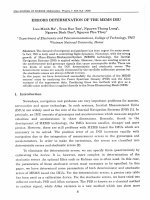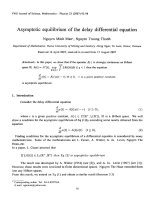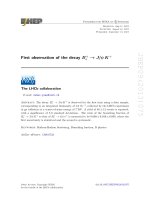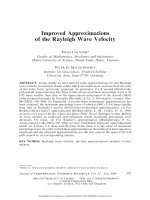DSpace at VNU: One result of the cyclic inequality
Bạn đang xem bản rút gọn của tài liệu. Xem và tải ngay bản đầy đủ của tài liệu tại đây (2.43 MB, 9 trang )
V N U . JO U R N A L OF SCIENCE, M a th e m a tics - Physics. T .X X II, N q 3 - 2006
ONE RESULT OF THE CYCLIC INEQUALITY
N guyen Vu Luong
D epartm ent o f M athem atics - Mechanics - Informatics
College o f Science , V N U
A bstract.
paring with
In this paper we present some inequalities which are obtained from com
n~ỹ
-pOL
Q
S(a, Ị3) = V ----------- ----------- 1------ llz l—_ J--------- Xn
k = l (Tfc+ 1 + x k+2)p
(Xn + Xi )0
(xi + X2)P
and
*(«.£) = ả
w here a e n + , 0 €
R + ,X i
€ /Ỉ+
k= 1
(i = ĩ~ỉí), R+ = {x e R\x > 0}.
I. I n tr o d u c tio n
Some cyclic inequalities have presented under simple forms but they are re a lly
difficult to prove. 1 he Shapiro’s inequality is a very special inequality and it is suprising
th at many m athem aticians have spent time on it.
W hen a = p = 1 we obtain the
Shapiro’s inequality
5 (1 ,1 ) ^ R ( l , 1)
( n > 3).
(1.1)
This inequality is correct for odd intergers less than or equal to 23 and for even
mtergers less than or equal to 12. For all other n, the inequality is false. For <ỵ G R + (3 6
R +, we will construct some inequalities between S(a,P) and R(a /3).
II. C ase a = p > 1
T h e o r e m 1.1.
If
Xi
Ễ i?+
(i = l , n ) , Q > l , n is an odd integer less than or equal to
23 and an even integer less than or equal to 12, then S( a, a ) > R ( a a)
(1.2).
Equality o f (1.2) holds i f and only i f X 1 = x 2 = ■■■= x n .
Typeset by
39
N g u y e n Vu L u o n g
40
Proof.
Using the inequality
n
by (1.1) we have
I I I . C a se a < p
In this case we obtain result.
T h e o r e m 1.2.
I f a & R +, (3 G i ỉ + , a < p then
(i) The inequality S( a , P) ^ R(a,(3) is not true for every positive
Xi
(i = 1, n)
(ii) The inequality S( a, /3) ^ R(a,(3) is not true for every positive
Xi
(i = 1,n )
Proof, (i) Taking Xi = 1, X2 = X3 = ... = I n = a > 0 we obtain
m
S {a ,0 )
1 r1
[4 .
2^
-
A
+
n —3,
a ^ -“ J
2aa
(1 + a)^3’
773— 7 ] +
= ^ g [l + ( n - l ) a “ - /ĩ].
Since /3 > a , it follows
lim 5 (a ,/J ) = 0
a —►
4-00
lirn R ( a , 0 ) = l g .
a —>-f oc
For large enough a in 5 (a ,/? ) and i?(a,/3), we have S(a,/3) < i? ( a ,/3). It follows th at
S(a,/3) ^ R (a,/3) is wrong.
(u) Taking Xi = a, X2 = £3 = ... = x n = 1(a > 0) we obtain
_,
m
aa
n - 3
2
+ (n - !)]•
Since (3 > a , it follows
lim 5 (a,/? ) = + 00
—►-foo
71 — 1
lim i? (a ,/3)
a—>+ 00
?2^
For large enough a in 5 (a,/3 ) and i?(a,/?), we have S (a,/3) > /ỉ(a ,/3 ). It follows th at
5(a,/3) ^ R ( a , P) is wrong.
O ne R e su lt o f the C y clic In eq u a lity
41
IV . C a se a > /3
Given
T h e o re m 1.3.
Xi
(i = 1, n) are positive numbers , p, q are positive integer
numbers such that p > q. We obtain
Jlf —
ill
4_
2
,_____ I
n-1
,
xn
>
(x2 4-X3)9
O 3 + Z4)9
(Xn+Xi)*?
( £ i + £ 2)9
29
Proof. Lets consider the case
p-q , _____ I Tp-
q ^ p — q<=>2q^p.
Applying the AM - GM inequality we have
(Z 2 + x 3)
Similarly, we have
22«x?
(x3 + X4)9
( x i + X2 ) 9
+ (X3 + x ị ) qxĩ, 2q > 29+ 1 x£ 9
+ (an + x 2)9x r 2? ^ 2^+1x r 9
Summing all above inequalities, we have
22qM + x r 2> 2 + Z3 )9 + • • • + XP-29( X! + X2)9 Ỉ? 2«+ i ( x r 9 + x r 9 + • • • + x r 9)-
( 1 .2 )
Moreover,
X1 _2<7(X2 + x 3 )q ^ 29-1x p 29(x | + xị).
We have
+ x \ ~ q H------ f x \ ~ q + x ự q H-------- h x%~q ^ (p - q)x[~2qx ị ,
v--------------------------------------------- V --------------------------------------------'
v---------------------------- V------------------------------'
p —2q t e r m s
q terms
x \ ~ q + x \ ~ q H------ h
H------ + x ự q ^ (p — ợ )x i_2gx |.
v---------------------------------------------V ------------------------------------------- '
v---------------------------- V------------------------------'
p —2q t e r m s
q terms
Taking sum of (1.3) and (1.4), we obtain
2 { p - 2 q ) x \ q + qxp2 q + q x ị q ^ (p - q )x \ 2q(x ị + xị).
(1.3)
(1.4)
N gu yen Vu L u o n g
42
It follows that
' x \ ~ 2q{x 2 + x ^ ) q ^ —------ [2{p - 2q)xỊ~q + qx%~q + qx%
P-Q
<
2 ^ [ 2{pr M
1 p-q
x pr
1
+ - S — xp2- q + - ^ — x ị - q\
p-q 2
p-q
Similarly, we obtain
x r 2q( x 3 + x 4) 9 ^ 2« - l l2{P- - ^
q-q
x p2- q +
p -q
x r 29( * i + x 2y ^ 2^-1[2(? ~-^ x r ? + —
n
v
q-q
'
p-q
p-q
x \-q+
p-Q
Taking sum of inequalities, we have
x ự 2q( x2 +
X z)q
+ x^_2g(x3 + x 4)q + -----f x?~2q(xi + x 2)q ^
^ 2 p -q
p -q
<=> x pl~2q( x 2 + x 3)q H------- h x£~29(xi + x 2)q ^ 2?( x p <7+ x ự q H-----+ x£-9 ).
Taking sum of (1.2) and (1.5) we obtain
22qM > 2q{x[-q + x% 2 + • • • + xpn- q)
« M > i ( i f - ’ + 4 ' ’ + • •■ + * r » )
*) For the case q > p — q t=> 2q > p.
Applying the AM - GM inequality, we have
q = u ( p - ợ) +
1 ^
u < p -
g
9P
—— ' +
+ x 3)p q + • ■• + (x2 + x 3)p_9+ 2p_q ^(x2 + x 3)i;x^ q
(x2 + x 3)9 V
---------------------- v------------------------------- /
7
u
2 p —q —\)
terms
2P . - ỵ - y
> (u + 2)2 “+2“ x 2 u+2
^ (u + 2)2p- qx \ - q
Similarly, we have
(x3 + X4)9
OPx.P
(xi + x 2)q
+ u ( x 4+ x 3)p- q + 2p- q~u • (x3 + x 4)vx%-q~u > (u + 2)2p- '?x£-
+ u ( x i + x 2)p~ 9 + 2 P - « - a ( x 1 +
x 2r x 5 T q- v
+
2)2r-*xpn- q
(1.5)
O n e R e su lt o f the C yclic Inequality
43
Taking sum of inequalities we have
2PM + u[{x 2+ x 3)p~q + (x3 + x 4)p~q 4------ f (xn +
X i)p~ q
+ (xi + X2 )p~q]+
+2*-«-v[x*-q- v{x2 + x 3)v + ... + x*-*-v(Xl + x 2)v]
> ( u + 2 ) 2 V - \ x \ - q + a*-* + • • • + x r 9).
(1.6)
We have
u [ ( x 2 + x ?.)v q + ■• • + ( x i 4- x 2y ~ q] <
€ u 2 p- q x ự i + x ự o
' 2
l zT '+ zr* ,
•
F"
•
. * r 9 + x r 9i
—
2" —
9 + x p 9 + • • • + x r 9),
(1.7)
2V-«-v { x \ - q- V(x2 + x 3)v + • • ■+ x r 9“ " (x i + ®2)1
T o 4- T o
/ r 11 _L 'T*V
<; 2P - « [ - l ± ĩ ỉ . XlP - 9 - + ... + a.P-9- v . £ l + £2 Ị
X P - V 4-
(1 8)
J_ „ p - q
. . . _l
Ĩ 9 + *1 9 • • • + x p 9 + x p + • • • + * r ? > (p V-------------- ' ^----------V---------- *
te r m s
p -q -v
V
te r m s
and
xị' q +
q . •. + x \ - q + xp
3- q + • • • + x ự q > ( p - q)xp1- q- vx v3
N
>---------------- V------------' s—
---------- V------------------------------------ '
p —q—v
terms
V
terms
It follows th at
( p - g - v)x rg+
+
2
v- x r q > ( p - q ) x l - ^ { ^ ± ^ )
2( p - q )
P -9
22(p —q)3
Similarly, we obtain
p - q- v , x
2
1
xp_g_
3 ± £ i) ^
2
x ^ + z |
[
2
P - (1 ~ V p - q
—
x p- q +
v
x p- q
p - q X1 + 2 ( p - q) x * + 2 ( p - qf *
’
___ V
p - q - v
1p - q
n
2(p-q) 1
_V_____
+ 2 (p -
qf2 ■
Taking sum of all above n inequalities we have
s P - i - ^ ĩ S + ĩ ĩ ) + . . . + x p - ^ ( ĩ l p l } ^ {P _ ^ L z l + _ H _ ] ( i r + . . . + x p - q)
z
2
p —q
p —q
q + x p2 - q + - - . + x pn- q.
(1.9)
N g u y e n Vu L u o n g
44
Since (1.8) and (1.9), it follows th at
p-q-v
(X 2 + X ^ y + ■• • + x £ 9 v ( x i + X 2 ) v ] ^ 2P q ( x \
q + ■■■+
q).
( 1.10)
Taking sum of inequalities (1.6), (1.7), (1.10) we have
2PM ^ [ 0 + 2)2p- q - u2p- q - 2p- q} ( x ự q + x pf q + • ■■+ x ự q)
o 2PM > 2p- q(xp1- q + x ự q + • • • + xp- q)
<i=> M >
+ x 2~q +------- +■Xn~Q)-
In order to consider the case a , /3 are posotive num bers, we review the necesary inequalities
1) Given a , b are positive numbers and a ^ 1, we have
2) Given a, b are positive numbers and a + /3 = 1, we have
(1 .12)
a a + (3b ^ a a b P .
3) Given a ,b ,a i ,Q 2 are positive numbers and ữ ^ l , ữ i + 0 2 = 1 we have
(ữi ữ + Ơ2b)a ^ 0;iaQ< + Oi2^a ■
T h e o r e m 1.4. L et
Xi
e R+
(i = 1, n ) , a e R +, 0 €
xg
x°
p
(x2 + x 3)£ + ( l 3 + x4)0 +
w ith 1 < (3 <
+ (xi +
Proof. We have
Taking sum of all above n inequalities, we have
^
(1.13)
we have
One. R e su lt o f the C y c lic In e q u a lity
45
Since /3 ^ 1, apply the inequality (1.11) we have
x“ ~2/3(x2 + £3)^ ^ 20 - 1x°~2i3(x%+ £3).
a - 2/3
p
Since ------ — H---- — p = 1, apply the inequality (1.12) we have
0
Ot — (3
a - 2/3
a —/?
a-23
o x“
^
1
8 ^ f O t - 2 P
^
p
\< *-0
XI + —~ X 2 )
\ a - p a - p )
Since 1 ^ / ? ^ — - > l ^ / 3 ^ a - / 3 and apply the inequality (1.13) we have
x t * 4 s ( ^ | X1 +
\ a —p
Ct — fj
< 2 - ^ r *
a -/3
)
+ - ^ x
a - Ị3
OL—Ị3
2
Similarly, we have
xX,a ~2^ x* (33<^ OL~
I
a _ 0 *Ta-P
r
p 0~—/?
Ta~^
It follows th at
o /5- l
z
a - 2 /3 /
X!
/3
.
/?\ ^
o / 3 - l [ 2 ( ^ — 2 /3 )
a - p
ot— 0
X1
0
a -/3
,
+ — ...n X2
+
a - p
_a-
0
/3g 3
a - p ú ']
It follows th at
c*
Xr
-IIX2 +
X3J
< - 2 / 3 _ 1 [ ^ ^ _____ I
[ a _^
x^ r
Q —Ị3 r
Q_/3
I
a ^— p
T ?~ P ]
J
Similarly, we obtain
x j - ^ x s + x t )» < 2's- ‘ [ ^ r | 2 x r ' s +
a-/?
a - 0 đ
x r 2i,( * i+ Xj)'5 s 2 « - ' ! ^ —
a - /3
+ - ^ —x r 0 +
a - (3 L
a - /3
a - (3 *
Taking sum of all above inequalities, we obtain
* r v (*a + x3)/? + • • • + x “ _2/?(xi + x2)^
+ x “- p + ■■. + X«-P).
Adding (1.14) and (1.15) we have
22f3P > (20+l - 2 P ) { x r 0 + * r * + • • ■+ < ~ 0)
p > ị ( x r 0+ ^ + - - -
(1.15)
N g u y e n Vu L u o n g
46
T h e o re m 1.5.
Let Xi G
(z = l , n ) , Q £
satisfy conditions
G
0 > p \ w +D
and /3 = u (a — P) + V where u is positive integer and V ^ 1. We have
rpOL
cx
1
rpOí
p = 7(x2 —
Tfl + 7(x3 —
- f x 3)^
+ x 4)^ + • • ■+ 7T
> è2^( x ĩ
+ ■• • + x r * ) .
Proof. Applying AM - GM inequality, we have
^
— — Jp + (X2 + Xs)a ^ + - - - + (x2 + Xz)Q ^ + 2 a ^ v(x2 + £ 3 ) ^ 1* ^
u terms
2 q - /ớ3- -„u
2or-
ĩ*amZ
°lzê=
F ~ỊL
v
^ ( u + 2 ) 2 ~ ^ ~ x 1 u+2
_
n
^
Q
= ( u + 2 )2 a - /?x “ _/3.
Similarly, we have
2a x£
+ u (x 3 + x 4r -/3 + 2a - ^ ( x 3 + x 4)vx%-0- v > { vl + 2)2a - f3x 2a - /3
(x3 + x4)£
2° x "
+ u (x i + £2)Q^ + 2a - /J- " ( x 1 + x2r * r ^ v ^ (u + 2)2a- px n a -<3
(xi + X 2)P
Taking sum of the above n inequalities we have
2a P + u [ ( x 2 + X 3) Q- /3 + • ■• + On + Xi )a~0] + 2a - (3- v [ x r f3~V(x2 + x 3y + • ■• +
■• • + x an - 0- v{xx + x 2)} ^ (u + 2)2Q- ^ ( x r /? + X * - 0 + • • • + x “- 0 ).
(1.16)
(ỵ
1
Since the assumption — > ^ ( / ? + l ) < i = > a - / ? > l , w e have
Ld
Li
Q —Q
2 ° - p [ ĩ 2í —
u[(x2 + x?)a ~p 4------- h (a?! + x 2)q-/?] ^
.
_ c t — (3
X3
_ a —3
.
+' • • • +1 1
ol— Q
-
2
2
^ u2a- ^ { x ^ i3 + x%-& + • • ■+ x « - p )
(1.17)
Since V ^ 1, we have
[x« -/? -" (x2 + X3y + ... + x Z~ 0- v (xi + x 2)v]
a- B' . . a- 3- v X2+X%
„
xV + xV,
O ne R e su lt o f th e C y c lic In e q u a lity
47
Applying the inequality (1.12) and (1.13), we have
a- p- v
X1
V ^
x2 ^
i a
~ P - v _
\
a- p
,
\a ~p
a —(3
a - p - V a -p
a -p
Xl
^
V
----- ——5X2 )
_ n
,
)
v
O'-/3
+ ^ Ớ X2•
Similarly, we have
a c -p -v
V ^
a
r
~
0
—
v r < * -0
a — /3
Xl
ị
v
a —(3
+ ^
X3•
Taking sum of 2 inequalities, it follows th at
CX-P-V, V . v\ ^ 2(q —p — v) OC-P
V
a-P ,
v „ot-0
xl
[x 2 ^ x 3 ^
— 3 ---- X1
“I---------0 X2
“!-------- n X3
a - /3
a - /3 z
a - (3 6
p a - P c t - p - v x 2 + x 3 ^ ^ a- fi r CX - /3 - V a - / 3
V
p
V
2
•
s2
1
2 { a — /3)
Q -/J
a_p
+ 2 ( ^ 3 ) I3
1-
Similarly, we have
O<2 - 0 r
oc-P -vX3
+ x 4 ^
2
<2
o a -/3 rQ -
0 - v
1 0^3
a-0
,
v
I?
2 (0 - 7 ? )
a -/?
,
V
+ 2 ( ^ g ) x“
a _0
1
2^-/3 o - / ? - f g l + x 2 ^ 2Q~/3f- ~ p ~ v x <*-P I ___ v
x a-p ,
v
a-/?l
2
^
1 a -/?
2(a —/Ớ)
+ 2 ( a - / 3 ) x2
JTaking sum of n inequalities and applying (1.18), we obtain
2«-/»-*[I ? - / » - ( ira + l 3 )« + . . . +
^
^
^
z A z l. + - v
[ a -p
+ a - p m
2 a - ff[a
+ x 2n
+
x ? _/5 +
2
+
x a~P)
_____ f
+ xn
J
2 “ - ^ ( x r / ? + * r /3 + - + < - /3).
(1.19)
Since the inequality (1.16), (1.17), (1.19), it follows
2a P ^ [(u 4- 2)2a ~^ - u2a~p -
+ . . . + x a~P)
> 2 ° - ^ + ! ^ + - + ^ )
1
« p > i2P( i r i + « r i + - + c ' ’)
R eferences
1. D .s. M itrinovic, J.E Pecaric and A.M. Fink, Classical and new Inequalities in Anal
ysis Kluwer academ ic publisher 1992.
2 . G.v. Milovanovic, Recent Progress in Inequalities,Kluwer academic publisher 1996.









